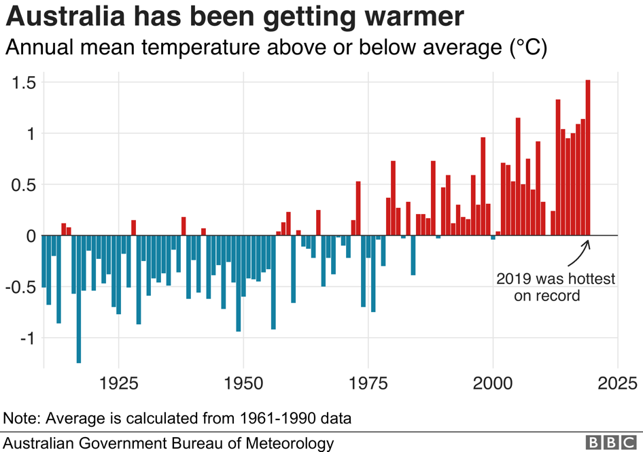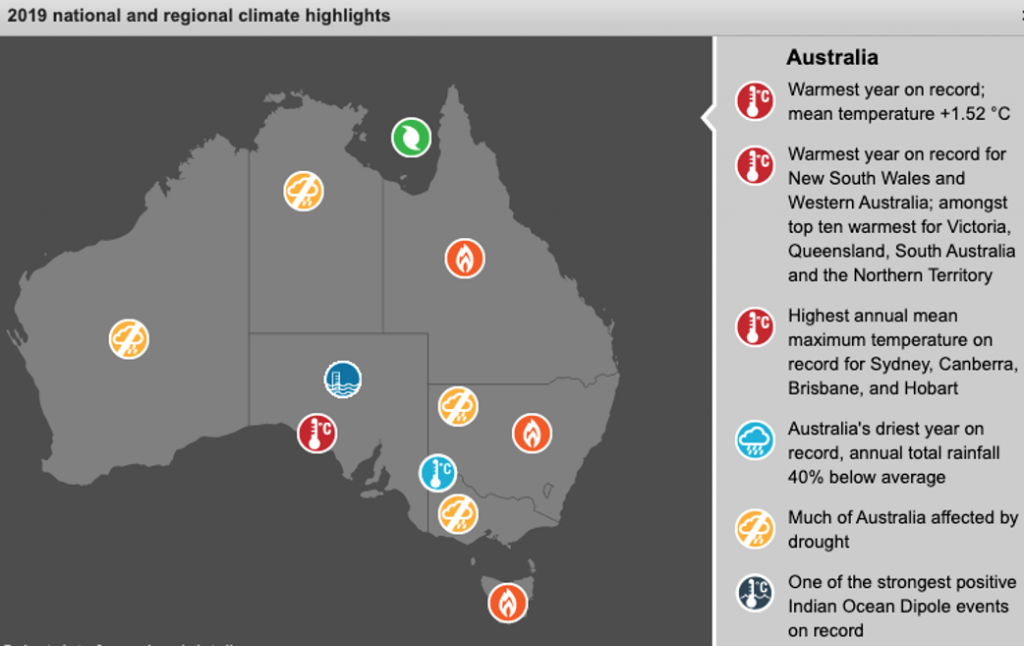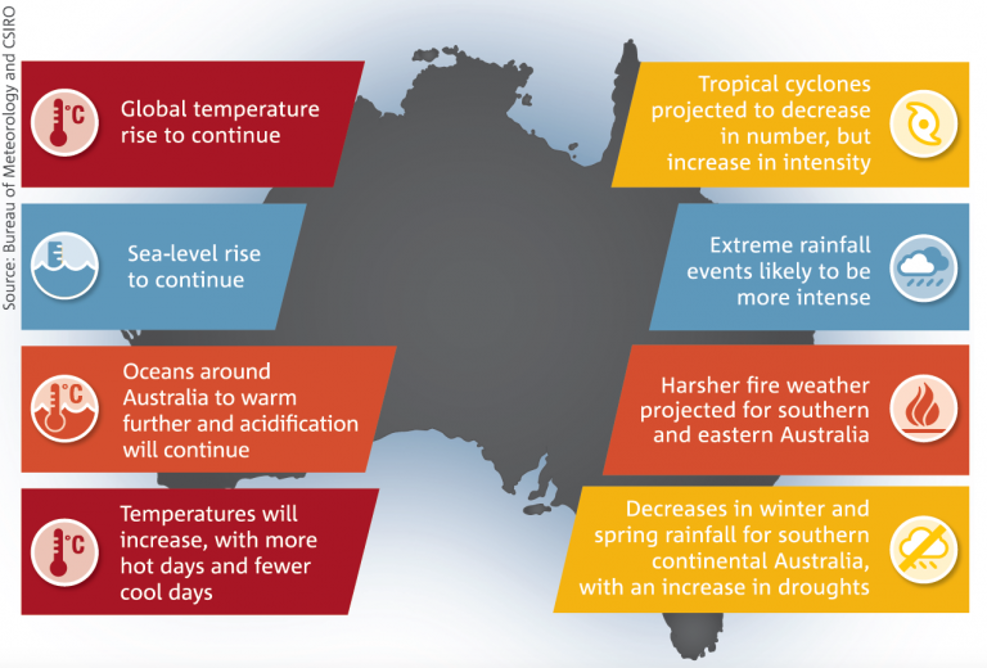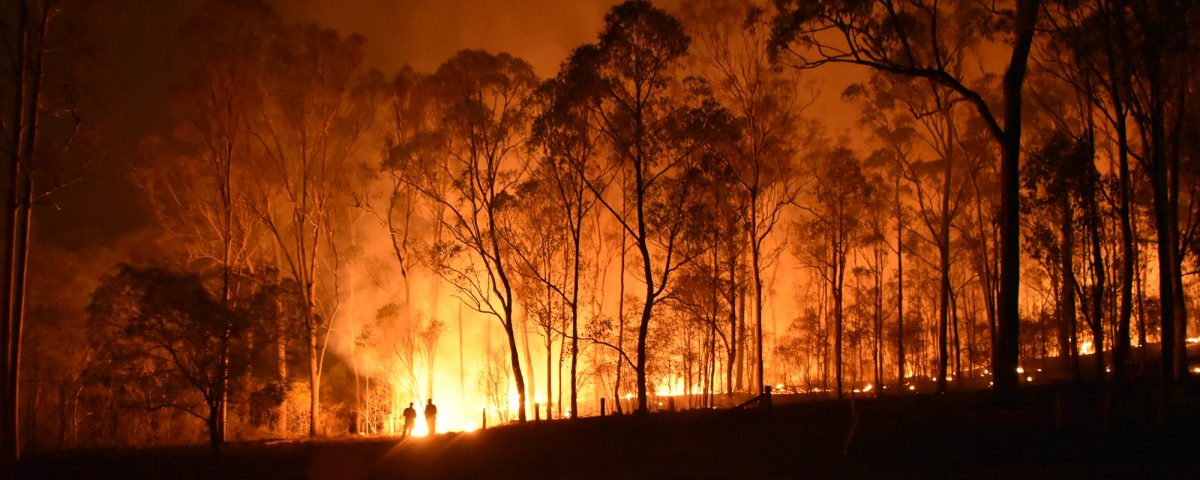
New asset notification procedure
January 30, 2020
Risk Management Resources
February 3, 2020In the light of the ongoing bushfire crisis throughout Australia, we would like to remind our Members of the risks to the higher education sector posed by this huge-scale event. For both Members currently near fire fronts and those safely out of harm’s way, the impact of this fire has the potential to reach far beyond the immediate damage of the flames.
More than 60 fires continue to burn in NSW and VIC at the time of writing and with hot and windy conditions forecast to continue, the crisis has no end in near sight.
A combination of severe weather conditions has created the perfect storm for this disaster to occur. Australia’s temperature has been rising steadily, with 2019 coming in as the hottest year on record according to the Bureau of Meteorology.

Meanwhile, Australia was also experiencing the effects of the strongest positive Indian Ocean dipole event since 1997. This caused a lack of rainfall and the resulting severe drought. When combined with a negative Southern Annular Mode (SAM) which controls the latitude of hot dry westerly winds, fire conditions became diabolical.
Both of these weather drivers have now returned to neutral, with the monsoon season bringing wetter conditions to northern Australia. This moister air is contributing to sporadic storm activity in the south-east of the continent. Notwithstanding this, it is predicted that a drier-than-average January to March is likely for eastern Australia.
As the temperature continues to rise, the fire season in Australia starts earlier and ends later, and as other effects of climate change continue to manifest and reveal their true extent, major bushfires are unfortunately not likely to be a one-off event.
While none of our Members have experienced any losses this fire season so far, it serves as a timely reminder of the importance of planning for the very real risk posed by fire. Bushfires currently account for around 10% of Unimutual’s fire-related losses, but this figure may rise in line with future weather predictions.
The infographic below from The Bureau of Meteorology’s 2019 annual climate statement illustrates the state of Australia’s climate in this past year, with soaring temperatures and the driest year Australia has ever recorded.

The infographic below is from a 2016 joint report from The Bureau of Meteorology and CSIRO but remains relevant and provides an excellent summary of the key weather trends.

Available resources to help you plan for a fire
If you are located near a fire or near any bushland, it’s important to be prepared to act immediately. Do you have an emergency plan?
- Bushfire planning: The bushfire risk management checklist contains information to help you prepare an emergency and evacuation plan as well as the following:
i. Preliminary planning
ii. Preparing a Bushfire Emergency and Evacuation Plan (BEEP)
iii. Pre-season preparation and site hardening
iv. An approaching bushfire
v. On the fire ground
vi. Post fire recovery
- Building protection and compliance: Are all of your buildings and other assets reported to the Mutual and therefore included within your protection? The form and a reminder of the process to report a new building is available here.
Are these buildings compliant with all relevant building safety guidelines including the removal of any non-compliant aluminium composite cladding. If you aren’t sure, please refer to our emerging risk report on aluminium composite cladding which contains helpful advice on how to ensure that your buildings are compliant. Find part one here and part two here.
The building risk assessment guideline is designed to assist facilities managers to assess, quantify and mitigate building risks associated with bushfire and flooding. The process involves the following steps:
i. Perform a desk top review to identify buildings which may be at risk from natural perils including bushfire, flooding and windstorms
ii. Inspect those buildings that may be exposed to natural perils and verify the location exposure by undertaking a “rapid” COPE based risk assessment
iii. Undertake a more detail risk assessment of “at risk” buildings
iv. Identify specific risk mitigation strategies, their costs and benefits.
If you need help using any part of this research, please contact Simon at simon.iliffe@rmml.com.
For some front-line tips on how to fight the fire threat through housekeeping and maintenance, detection and protection, and design and specification, please see this article (please note that while the content remains relevant, the figures may be out of date).
- Emergency alert systems: Make sure that your emergency alert system (EAS) is incorporated into your emergency and evacuation plans. There is a useful article on how to update your EAS in preparation for an event here.
- Power: And if you’re not in the path of the fire? Unfortunately, you could still be impacted by a power cut. The Australian Energy Market Operator (AEMO) on has warned that “severe and extreme bushfire conditions” could escalate and threaten the grid again. Bushfires can bring down vital transmission lines and key power infrastructure. Power cuts introduce the risk of controlled environment failure as well as fire resulting from the electrical failure. As many of you will be aware from previous claims, when fridges/freezers lose power and warm up to ambient temperatures, this can cause the stored chemicals to become unstable and ignite causing a fire.
Severe storms and flooding
While it’s hard to feel threatened by flood or severe storms when the weather is so hot and dry, ask any Canberran the likelihood of an extreme storm event occurring as bushfires rage on the outskirts of the city.
Under the skies of climate change and a new meteorological paradigm, extreme and rare weather events are expected to become more frequent, and this includes storms and extreme rainfall events.
To prepare your institution for this risk, please see the above linked building risk assessment and resilience guideline.
Please find a checklist here for preparing your campus against the threat of severe storms. It contains the below sections:
Section 1 – On ground preparation
Examines all the actions to ensure drainage and emergency systems will work effectively
Section 2 – Review the emergency plans
Steps to take to make sure your plan are up-to-date
Section 3 – BoM Warning issued
Who to advise and what to do when an official BoM warning has been issued
Section 4 – The storm has arrived
Should we stay or should we go and some simple things you can do
Section 5 – After the storm has passed
Conducting a preliminary damage assessment
Section 6 – Detailed damage assessment
Who can help with the process and the things to look for that may not be immediately obvious
Section 7 – Project and Contractor Management
Developing a scope and program of works and managing the works safely and cost effectively
Section 8 – Upgraded Specifications
If we have to rebuild it – should we build it differently
Please also consider where research and other valuable items are physically located as items on the first floor will naturally be more susceptible to water damage from flooding.
If you would like guidance on how best to use any of these resources, please contact Simon at simon.iliffe@rmml.com.
Read Simon’s latest article summarising claims in the 2018/19 insurance year and offering his outlook for risks and trends we’ll be seeing in 2020.



